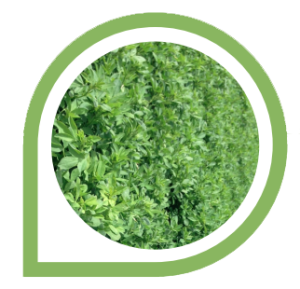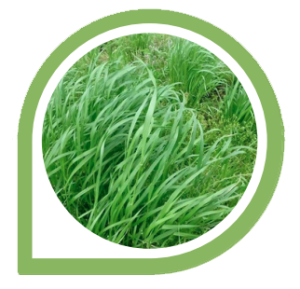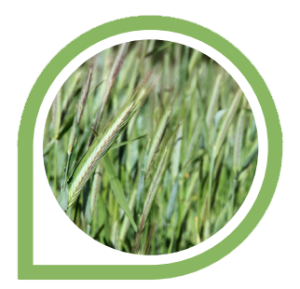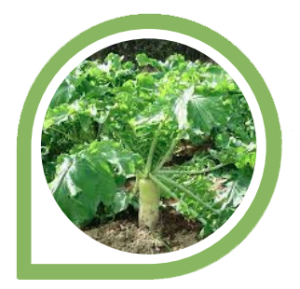Here you will Find all the info of our products

PRODUCTION POTENTIAL:
- 8 – 15t/ha/annum
TYPE:
- Subtropical Legume
- Semi-winter dormant, dormancy 6
PRODUCTION PERIOD:
- Perennial, Spring, summer & autumn
STRENGTHS:
- Reliable cultivar, can withstand severe heat and cold
conditions - Moderately tolerant to soil salinity
- Responds quickly to spring and summer rainfall/irrigation
FEEDING VALUE:
- Crude protein: 15 –25%
- Digestibility: 60 – 75% DMD
USES:
- Pasture & hay
SOIL REQUIREMENTS:
- Grows across a wide range of soil types
- Prefers deep, well drained soils
- Prefers a neutral to high pH and no acid saturation
ESTABLISHMENT:
- Plant during February – May / August – September
- Broadcast at 8 – 12.5 kg/ha dryland and 20 – 25 kg/ha
irrigated
MORPHOLOGICAL DESCRIPTION:
- Crown position on soil surface with deep penetrating
taproot - Stem coarse to medium
Seeds green to yellow to light brown; kidney shaped to
avoid; 1 – 2.5 mm x 1 – 1.5 mm; 440 000 – 500 000 seeds/kg
LUCERNE / ALFALFA :
AURORA
I M P O R T E D S E E D

PRODUCTION POTENTIAL:
- 8 – 15t/ha/annum
TYPE:
- Subtropical Legume
- Semi-winter dormant, dormancy 6
PRODUCTION PERIOD:
- Perennial, Spring, summer & autumn
STRENGTHS:
- High nutritive value
- Double purpose cultivar – hay and grazing crop
FEEDING VALUE:
- Crude protein: 15 –25%
- Digestibility: 60 – 75% DMD
USES:
- Hay & Grazing
SOIL REQUIREMENTS:
- Grows across a wide range of soil types
- Prefers deep, well drained soils
- & pH range of 6.5 – 8.0
ESTABLISHMENT:
- Plant during February – May / August – September
- Broadcast at 8 – 12.5 kg/ha dryland and 20 – 25 kg/ha
irrigated
MORPHOLOGICAL DESCRIPTION:
- Deep penetrating taproot and stem coarse to medium
- Seeds green to yellow to light brown; kidney shaped to
avoid: 1 – 2.5mm x 1 – 1.5mm; 440 000 – 500 000 seeds/kg
LUCERNE / ALFALFA :
SIRIVER

PRODUCTION POTENTIAL:
- 8 – 18t/ha/annum
TYPE:
- Subtropical Legume
- Winter active, dormancy 9
PRODUCTION PERIOD:
- Perennial, Spring, summer, autumn & mid-winter
STRENGTHS:
- Moderately winter active
- Moderately tolerant to soil salinity, tolerate high
temperatures - Highly nutritive, good hay cultivar & excellent persistence
FEEDING VALUE:
- Crude protein: 15 –25%
- Digestibility: 60 – 75% DMD
USES:
- Hay
SOIL REQUIREMENTS:
- Prefers deep, well drained soils
- pH range of 5.5 – 7.01
ESTABLISHMENT:
- Plant during August – September or February – May
- Broadcast at 8 – 12.5 kg/ha dryland and 20 – 25 kg/ha irrigated
MORPHOLOGICAL DESCRIPTION:
- Deep penetrating taproot, crown position above ground
- Stem medium
- Seeds green to yellow to light brown; kidney shaped to
ovoid; 1 – 2.5 mm x 1 – 1.5 mm; 440 000 – 500 000 seeds/kg
WINTER SEEDS :

WESTERWORLD RYEGRASS:
- TERTRASTAR
OATS:
- KOMPASBERG
- SWK 001
- SSH 421
- SSH423
- SAIA
RYE:
- SSR 727
- SSR 729
JAPANESE RADISH:
- NOOITGEDACHT
WESTERWORLD RYEGRASS :
TETRASTAR

PRODUCTION POTENTIAL:
- Dry matter production: 7 – 18 t/ha/annum
TYPE:
- Temperate Grass
- Tetraploid, Westerwold Type
PRODUCTION PERIOD:
- Annual, Autumn, winter & spring
STRENGTHS:
- Fast establishment, good cold tolerance
- Selected for seedling vigour, productivity and regrowth
potential - Increased palatability; higher animal production
FEEDING VALUE:
- Crude protein: 15 – 22 %
- Digestibility: 55 – 70 %
USES:
- Pasture, hay, silage & cover crops
SOIL REQUIREMENTS:
- Prefers deep fertile soil; high soil moisture holding capacity
- pH range of > 5.0
ESTABLISHMENT:
- Plant during February – May and September- October
- Broadcast 25 – 30 kg/ha irrigated
MORPHOLOGICAL DESCRIPTION:
- Bunch type, erect growth habit, produces abundant tillers
- Grows up to 30 – 91cm tall
- Leaves shiny with smooth edges; upper surface prominently rigged
- Lower surface glossy, smooth and hairless with a prominent midrib
- 4 – 10 mm x 6 – 20 cm; young leaves rolled, Seeds brown; l
- anceolate 2.6 – 7 mm x 0.7 – 1.7 mm 250 000 – 500 000 seeds/kg
OATS :
KOMPASBERG

PRODUCTION POTENTIAL:
- Dry matter production: 3 – 9 t/ha/annum
TYPE:
- Temperate, Forage cereal
PRODUCTION PERIOD:
- Winter & spring, Annual
STRENGTHS:
- High forage production
- Smother crop for weed suppression
FEEDING VALUE:
- Crude protein: 10 – 16 %
- Digestibility: 55 – 65 %
USES:
- Grain production, hay, silage & grazing, companion crop
SOIL REQUIREMENTS:
- Widely adapted to most soil conditions, avoid waterlogged
soils - pH range of 5.5 – 7.0
ESTABLISHMENT:
- Plant during January – May
- Seeding rate of 40 – 65 kg/ha dryland and 75 – 100
kg/ha irrigated
MORPHOLOGICAL DESCRIPTION:
- Erect, tufted grass, 0.75 – 1.5 m tall
- Leaf blade is flat, narrow and veined; taper to a fine point; rolled
in bud; 15 – 30 cm x 0.6 – 1.2 cm - Long, narrow yellow, brown seeds; 0.6 – 1 cm
OATS :
SWK001

PRODUCTION POTENTIAL:
- Dry matter production: 5 – 9 t/ha/annum
TYPE:
- Temperate, Forage cereal
PRODUCTION PERIOD:
- Winter & spring, Annual
STRENGTHS:
- Good hay crop
- Fair lodging resistance
FEEDING VALUE:
- Crude protein: 7 – 8 %
- Digestibility: 70 %
USES:
- Hay, silage, winter cover crop & grazing
SOIL REQUIREMENTS:
- Widely adapted to most soil conditions, avoid waterlogged
soils - pH range of 5.5 – 7.0
ESTABLISHMENT:
- Plant during January – April; April – May
- Seeding rate of 40 – 50 kg/ha dryland and
75 – 100 kg/ha irrigated
MORPHOLOGICAL DESCRIPTION:
- Erect, tufted grass, 1.5 – 2 m tall • Leaf blade is flat, narrow
and veined; taper to a fine point; rolled in bud; 15 – 30 cm
x 0.6 – 1.2 cm • - Long, narrow yellow, brown seeds; 0.6 – 1 cm
OATS :
SSH421

PRODUCTION POTENTIAL:
- Dry matter production: 5 – 8 t/ha/annum
TYPE:
- Temperate, Forage cereal
PRODUCTION PERIOD:
- Winter & spring, Annual
STRENGTHS:
- Good forage production for grazing
- Multi purpose crop
- Short grower
FEEDING VALUE:
- Crude protein: 7 – 10 %
- Digestibility: 55 – 70 %
USES:
- Grazing, hay, silage, companion crop & winter cover crop
SOIL REQUIREMENTS:
- Widely adapted to most soil conditions, avoid waterlogged
soils - pH range of 5.5 – 7.0
ESTABLISHMENT:
- Plant during January – May
- Seeding rate of 40 – 50 kg/ha dryland and 75 – 100
kg/ha irrigated
MORPHOLOGICAL DESCRIPTION:
- Erect, tufted grass, 1.2 – 2 m tall
Leaf blade is flat, narrow and veined; rolled in bud; 15 – 30 cm x 0.6, 1.2 cm - Long, narrow yellow, brown seeds; 0.6 – 1 cm
OATS :
SSH423

PRODUCTION POTENTIAL:
- Dry matter production: 5 – 8 t/ha/annum
TYPE:
- Temperate, Forage cereal
PRODUCTION PERIOD:
- Winter & spring, Annual
STRENGTHS:
- Good forage production for grazing
- Multi purpose crop
FEEDING VALUE:
- Crude protein: 7 – 10 %
- Digestibility: 55 – 70 %
USES:
- Grazing, hay, silage, companion crop & winter cover crop
SOIL REQUIREMENTS:
- Widely adapted to most soil conditions, avoid waterlogged
soils - pH range of 5.5 – 7.0
ESTABLISHMENT:
- Plant during January – May
- Seeding rate of 40 – 50 kg/ha dryland and 75 – 100
kg/ha irrigated
MORPHOLOGICAL DESCRIPTION:
- Erect, tufted grass, 1.2 – 2 m tall
- Leaf blade is flat, narrow and veined; rolled in bud; 15 – 30 cm x 0.6, 1.2 cm
- Long, narrow yellow, brown seeds; 0.6 – 1 cm;
35 000 – 75 000 seeds/kg
OATS :
SAIA

PRODUCTION POTENTIAL:
- Dry matter production: 7 t/ha/annum
TYPE:
- Temperate, Forage cereal
PRODUCTION PERIOD:
- Winter & spring, Annual
STRENGTHS:
- Fast establishing, rapid forage production
- Smother crop for weed suppression
FEEDING VALUE:
- Crude protein: 7 – 8 %
- Dry matter digestibility: 70 %
USES:
- Grazing, hay, silage, companion crop & winter cover crop
SOIL REQUIREMENTS:
- Widely adapted to most soil conditions, tolerates low soil
fertility - pH range of 5.5 – 7.0
ESTABLISHMENT:
- Plant during January – May
- Seeding rate of 37 – 50 kg/ha dryland and
50 – 75 kg/ha irrigated
MORPHOLOGICAL DESCRIPTION:
- Erect, tufted grass, 1.5 – 2.0 m tall
- Fibrous root system and narrow leaves 15 – 30 cm x 0.3 – 0.75 cm
- Long, narrow greyish, black seeds; 0.6 – 1 cm
RYE :
SSR727

PRODUCTION POTENTIAL:
- Dry matter production: 3 – 9 t/ha/annum
TYPE:
- Temperate, Cereal grain
PRODUCTION PERIOD:
- Winter & spring, Annual
STRENGTHS:
- Quick short-duration rye with high leaf to stem ratio
- More volume; more production than oats
FEEDING VALUE:
- Crude protein: 14 – 18 %
Digestibility: 60 – 65 %
USES:
- Grazing, hay, silage, grain production & rotational crop
SOIL REQUIREMENTS:
- Grows best on well-drained loamy soils and tolerates sandy
soils
pH range of 4.5 – 8.0
ESTABLISHMENT:
- Plant during January – May
Seeding rate of 25– 50 kg/ha dryland and
50 – 80 kg/ha irrigated
MORPHOLOGICAL DESCRIPTION:
- Tall, hardy, tufted grass, 1.2 – 2 m tall • Stems ascending when young,
becomes more erect when older • Oblong shaped seeds; light brown;
0.8 cm long
RYE :
SSR729

PRODUCTION POTENTIAL:
- Dry matter production: 3 – 9 t/ha/annum
TYPE:
- Temperate, Cereal grain • Stooling type
PRODUCTION PERIOD:
- Winter, Annual
STRENGTHS:
- Very palatable grazing in winter, spring and early summer
- More volume; more production than oats
FEEDING VALUE:
- Crude protein: 14 – 18 %
Digestibility: 60 – 65 %
USES:
- Grazing, hay, silage, grain production & rotational crop
SOIL REQUIREMENTS:
- Grows best on well-drained loamy soils and tolerates heavy
clays and sandy soils - pH range of 4.5 – 8.0
ESTABLISHMENT:
- Plant during March-May and August
- Seeding rate of 20 – 25 kg/ha dryland and
40 – 50 kg/ha irrigated
MORPHOLOGICAL DESCRIPTION:
- Tufted grass, prostate when young • Grows 1 – 1.5 m tall with
extensive, fibrous root system - Oblong shaped seeds; light brown; 0.8 cm long
JAPANESE RADISH:
NOOITGEDACHT

PRODUCTION POTENTIAL:
- Dry matter production: 3 – 10 t/ha/annum
TYPE:
- Broadleaf
PRODUCTION PERIOD:
- Annual, Plant middle summer for autumn /
winter growth
STRENGTHS:
- Provides good fodder during winter
- Roots and leaves can be fed
FEEDING VALUE:
- Crude protein, leaves: 13 – 20 %
- Crude protein tuber: 7 %
USES:
- Grazing
SOIL REQUIREMENTS:
- Performs best on well drained, clay soil types, which retain
moisture - pH range of 5.5 – 6.5
ESTABLISHMENT:
- Plant during December – March
- Seeding rate of 3 – 5 kg/ha for bulb/tuber production and
5 – 12.5 kg/ha for grazing
MORPHOLOGICAL DESCRIPTION:
- Huge bulb/tuber; 3 – 8 kg
- Leaf blade is large, flat and hairy; 30 – 50 cm x 20 – 40cm
- Tiny, round shaped seed; 30 000 – 50 000 seeds/kg
322 Beverly Boulevard Los Angeles, CA 90048
– open 7 days a week from 7am to 9pm –

